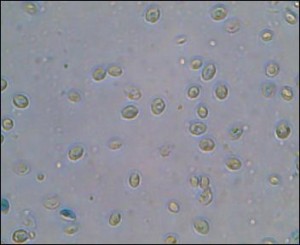Although I’m pretty sure I’d explained this before, I had a student ask me today what makes the bread rise. He’d been combining the ingredients to make bread for the student run business with a rather thoughtful look on his face. So I told him that yeast is a fungus that “eats” the sugar in the honey and “releases” carbon dioxide bubbles, which get trapped in the dough causing the bread to rise.
I could see the look of disgust racing across his face at the mention of fungi, so I asked, “Would you like to look at it?” He did, and he was not the only one. So after lunch I broke out the microscope, which we have not used much this year since we’re doing the physical sciences this year. A slide, a cover slip, a drop of the residue from the glass jar we used to mix the liquids for the bread, a quick (so very quick) demonstration of how to use the microscope and whallah.
Under 10 times magnification you could see hundreds of cells moving across the field of view. The students were impressed by how many there were. Under 40 times magnification you begin to see cell structures.

We’ll look at yeast again next year when we’re focusing on the life sciences, but when I think of the Montessori axioms that the role of the teacher is to prepare the environment and to follow the child, I think of situations like this. At this time, in this place, after kneading dough for half a year, the student asked the question, and everything was ready for him to answer the that question and whet his appetite for more.